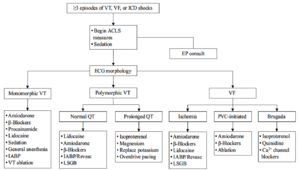Electrical storm: Difference between revisions
| Line 44: | Line 44: | ||
*Beta blockade: Minimize [[epinephrine]] use as much as possible | *Beta blockade: Minimize [[epinephrine]] use as much as possible | ||
**[[Metoprolol]] 2.5-5 mg IV q2-5 min to max of 15 mg | **[[Metoprolol]] 2.5-5 mg IV q2-5 min to max of 15 mg | ||
**[[Propranolol]] 0.15 mg/kg IV over 10 minutes followed by 3-5 mg q6h <ref>Nademanee K et al. Treating electrical storm: sympathetic blockade versus ACLS guided therapy. Circulation 2000;102:742-7.</ref> | **[[Propranolol]] 0.15 mg/kg IV over 10 minutes followed by 3-5 mg q6h <ref>Nademanee K et al. Treating electrical storm: sympathetic blockade versus ACLS guided therapy. Circulation 2000;102:742-7.</ref>; may be effective even if metoprolol fails | ||
**[[Esmolol]] 300-500 mcg/kg load over 1 minutes follwed by infusion at 25-50 mcg/kg/min initial dose | **[[Esmolol]] 300-500 mcg/kg load over 1 minutes follwed by infusion at 25-50 mcg/kg/min initial dose | ||
| Line 54: | Line 54: | ||
**Brugada | **Brugada | ||
***[[Isoproterenol]] is 1st line | ***[[Isoproterenol]] is 1st line | ||
***Avoid class I antiarrhythmics | ***Avoid class I antiarrhythmics | ||
===Inpatient=== | ===Inpatient=== | ||
Revision as of 01:26, 3 June 2015
Background
- Definition
- 3 or more episodes of sustained ventricular tachycardia, ventricular fibrilation, or ICD shocks within 24 hours
- Risk factors [1]
- CAD
- HFrEF
- Long QT
- DM2 is protective
- Causes
- Ischemia
- Electrolyte derangement
- Iatrogenic (i.e. QT prolonging medications)
- Hyperthyroidism
- Infection/Fever
Clinical Features
- Presentation as:
- Cardiac arrest
- Palpitations
- (Pre)Syncope
- ICD patient complaining of shock(s)
Differential Diagnosis
- Tachycardia (wide)
- ICD malfunction
- AF/SVT
- Oversensing
- Lead fracture
Diagnosis
Management

Proposed treatment algorithm for electrical storm[2]
Emergency Department
- Follow current ACLS guidelines if pulseless
- Analgesia / Sedation for all patients
- ACC recommends repletion of K to 4.5 in all cases [3]
- Amiodarone 1st line antiarrhythmic (preferred over lidocaine) for most cases
- Efficacy of lidocaine highest if actively ischemic
- Beta blockade: Minimize epinephrine use as much as possible
- Metoprolol 2.5-5 mg IV q2-5 min to max of 15 mg
- Propranolol 0.15 mg/kg IV over 10 minutes followed by 3-5 mg q6h [4]; may be effective even if metoprolol fails
- Esmolol 300-500 mcg/kg load over 1 minutes follwed by infusion at 25-50 mcg/kg/min initial dose
- Exceptions to above are:
- Torsades with known long QT
- Magnesium sulfate 1-2 grams IV over 1-2 minutes
- Potassium repletion
- If bradycardic between episodes, pace @ 90-120 or start Isoproterenol infusion @ 2 mcg/min and titrate to HR 90-100
- Brugada
- Isoproterenol is 1st line
- Avoid class I antiarrhythmics
- Torsades with known long QT
Inpatient
- Emergent revascularization if ischemic
- Ablation
- Left sympathetic ganglionic blockade
- Deep sedation / general anesthesia
- IABP / ECMO
Disposition
- CCU or cath lab
See Also
External Links
References
- ↑ Brigadeau F et al. Clinical predictors and prognostic significance of electrical storm in patients with implantable cardioverter defibrillators. Eur Heart J 2006;27:700-7.
- ↑ Eifling M, Ravazi M, Massumi A. The Evaluation and Management of Electrical Storm. Tex Heart Inst J 2011;38(2):111-21
- ↑ Zipes DP et al. ACC/AHA/ESC 2006 Guidelines for Management of Patients With Ventricular Arrhythmias and the Prevention of Sudden Cardiac Death. J Am Coll Card 2006;48(5):e247-346.
- ↑ Nademanee K et al. Treating electrical storm: sympathetic blockade versus ACLS guided therapy. Circulation 2000;102:742-7.


